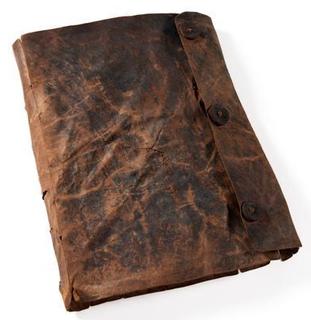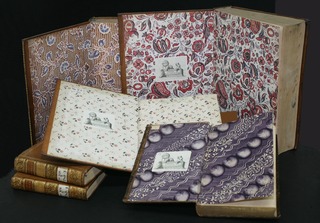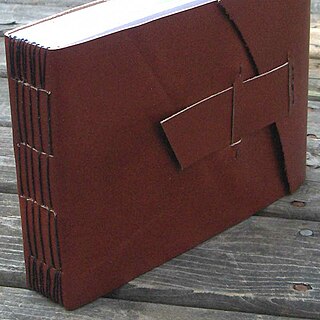
The codex was the historical ancestor of the modern book. Instead of being composed of sheets of paper, it used sheets of vellum, papyrus, or other materials. The term codex is often used for ancient manuscript books, with handwritten contents. A codex, much like the modern book, is bound by stacking the pages and securing one set of edges by a variety of methods over the centuries, yet in a form analogous to modern bookbinding. Modern books are divided into paperback and those bound with stiff boards, called hardbacks. Elaborate historical bindings are called treasure bindings. At least in the Western world, the main alternative to the paged codex format for a long document was the continuous scroll, which was the dominant form of document in the ancient world. Some codices are continuously folded like a concertina, in particular the Maya codices and Aztec codices, which are actually long sheets of paper or animal skin folded into pages. In Japan, concertina-style codices called orihon developed during the Heian period (794–1185) were made of paper.

Vellum is prepared animal skin or membrane, typically used as writing material. It is often distinguished from parchment, either by being made from calfskin, or simply by being of a higher quality. Vellum is prepared for writing and printing on single pages, scrolls, and codices (books).

The St Cuthbert Gospel, also known as the Stonyhurst Gospel or the St Cuthbert Gospel of St John, is an early 8th-century pocket gospel book, written in Latin. Its finely decorated leather binding is the earliest known Western bookbinding to survive, and both the 94 vellum folios and the binding are in outstanding condition for a book of this age. With a page size of only 138 by 92 millimetres, the St Cuthbert Gospel is one of the smallest surviving Anglo-Saxon manuscripts. The essentially undecorated text is the Gospel of John in Latin, written in a script that has been regarded as a model of elegant simplicity.

A treasure binding or jewelled bookbinding is a luxurious book cover using metalwork in gold or silver, jewels, or ivory, perhaps in addition to more usual bookbinding material for book-covers such as leather, velvet, or other cloth. The actual bookbinding technique is the same as for other medieval books, with the folios, normally of vellum, stitched together and bound to wooden cover boards. The metal furnishings of the treasure binding are then fixed, normally by tacks, onto these boards. Treasure bindings appear to have existed from at least Late Antiquity, though there are no surviving examples from so early, and Early Medieval examples are very rare. They were less used by the end of the Middle Ages, but a few continued to be produced in the West even up to the present day, and many more in areas where Eastern Orthodoxy predominated. The bindings were mainly used on grand illuminated manuscripts, especially gospel books designed for the altar and use in church services, rather than study in the library.

Wasōbon is a traditional book style in Japan that dates from the late eighth century AD with the printing of "Hyakumantō Darani" during the reign of Empress Shōtoku (764-770AD). The majority of books were hand-copied until the Edo period (1603–1867), when woodblock printing became comparatively affordable and widespread. Movable-type printing had been used from the late 16th century, but for various aesthetic and practical reasons woodblock printing and hand-copied remained dominant until much later. Japanese equivalents for "book" include 本 (hon) and 書籍 (shoseki). The former term indicates only bound books, and does not include scrolls. The latter is used for printed matter only. The most general term is 書物 (shomotsu), which means all written or printed matter that has been collected into a single unit, regardless of construction.

Traditional Chinese bookbinding, also called stitched binding, is the method of bookbinding that the Chinese, Koreans, Japanese, and Vietnamese used before adopting the modern codex form.

A bookmark is a thin marking tool, commonly made of card, leather, or fabric, used to keep track of a reader's progress in a book and allow the reader to easily return to where the previous reading session ended. Alternate materials for bookmarks are paper, metals like silver and brass, silk, wood, cord (sewing), and plastic. Some books may have one or more bookmarks made of woven ribbon sewn into the binding. Furthermore, other bookmarks incorporate a page-flap that enables them to be clipped on a page.

The Faddan More Psalter is an early medieval Christian psalter or text of the book of Psalms, discovered in a peat bog in July 2006, in the townland of Faddan More in north County Tipperary, Ireland. The manuscript was probably written in about 800 CE in one of a number of monasteries in the area. After several years of conservation work, the psalter went on display at the National Museum of Ireland – Archaeology in Kildare Street, Dublin in June 2011.

Bindery refers to a studio, workshop or factory where sheets of (usually) paper are fastened together to make books, but also where gold and other decorative elements are added to the exterior of books, where boxes or slipcases for books are made and where the restoration of books is carried out.

The endpapers or end-papers of a book are the pages that consist of a double-size sheet folded, with one half pasted against an inside cover, and the other serving as the first free page. Thus, the front endpapers precede the title page and the text, whereas the back endpapers follow the text. Booksellers sometimes refer to the front endpaper as FEP.

Coptic binding or Coptic sewing comprises methods of bookbinding employed by early Christians in Egypt, the Copts, and used from as early as the 2nd century AD to the 11th century. The term is also used to describe modern bindings sewn in the same style.

In the art of bookbinding, the longstitch technique is used for binding the sections (signatures) of a book without using glue. In Non-adhesive Binding: Books without Paste of Glue (1999) Keith A. Smith describes that binding a book with a "longstitch through a slotted cover" involves directly sewing each section through the cover, which has slots for attaching each section, and creates a pattern of staggered lines that is visible on the spine of the book.

In bookbinding, finishing refers to the process of decorating the outside of a book, including the lettering of the spine and covers, any additional tooling, and any inlays and onlays. Finishing can also include the gilding or other decoration of the edges of the book's pages.

In bookbinding, a section, gathering, or signature is a group of sheets folded in half, to be worked into the binding as a unit.
James Hayday (1796–1872), was a British bookbinder.
The Ethiopian bookbinding technique is a chain stitch sewing that looks similar to the multi section Coptic binding method. According to J. A. Szirmai, the chain stitch binding dates from about the sixteenth century in Ethiopia and Eritrea. These books typically had paired sewing stations, sewn using two needles for each pair of sewing stations. The covers were wooden and attached by sewing through holes made into edge of the board. Most of these books were left uncovered without endbands.
Yapp is an English surname, derived from an Old English word meaning "crooked, bent; deceitful; shrewd, smart". Notable people with the surname include:

Bookbinding is the process of building a book, usually in codex format, from an ordered stack of paper sheets with one's hands and tools, or in modern publishing, by automated processes. Firstly, one binds the sheets of papers along an edge with a thick needle and strong thread. One can also use loose-leaf rings, binding posts, twin-loop spine coils, plastic spiral coils, and plastic spine combs, but they last for a shorter time. Next, one encloses the bound stack of paper in a cover. Finally, one places an attractive cover onto the boards, and features the publisher's information and artistic decorations.

Book rebinding is the renewal or replacement of the cover of a book. Typically, this requires restitching or renewal of the glue which holds the pages in place.

August Sandgren was a Danish bookbinder. He was one of the best craftsmen of Denmark and a great designer who never compromised with the techniques of bookbinding.

















